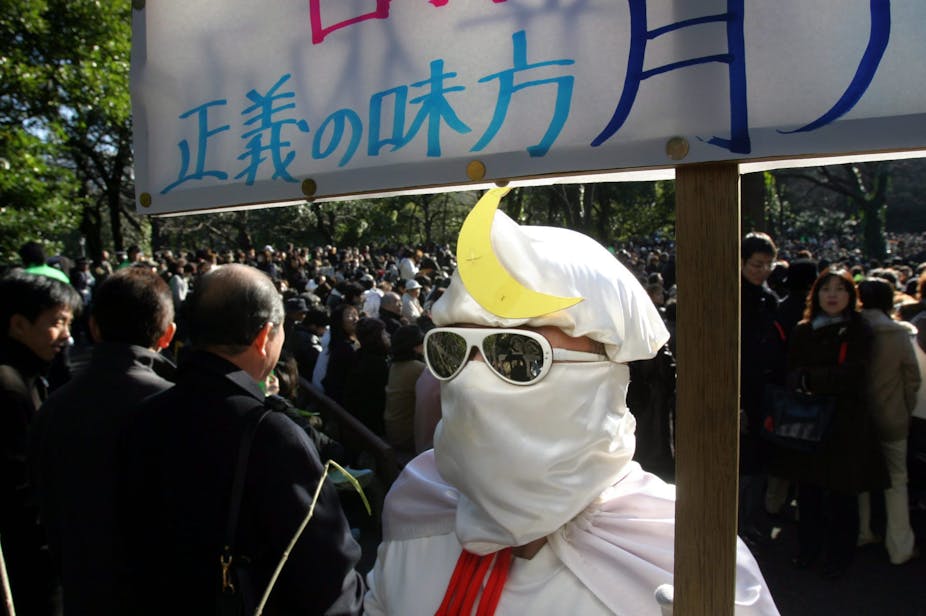Twenty years ago, I stepped off a plane as an excited teenager ready for a year’s exchange at a Japanese high school. Just a few days later, I was caught up in Japan’s worst case of domestic terrorism. Twelve people were killed and thousands affected when members of religious sect Aum Shinrikyō released toxic sarin nerve gas across Tokyo’s underground network.
The attack did not appear out of nowhere. The leadership of Aum had orchestrated a campaign of violence for years against opponents both within and outside the sect. Just nine months before the Tokyo attack, Aum members had released sarin in the city of Matsumoto, which killed seven. Police mistakenly focused on one of the victims, a man named Kōno Yoshiyuki, whose wife fell into a coma from which she would never recover.
After the subway attack, police finally turned their attention to Aum, arresting several dozen members – 13 were ultimately sentenced to death. We often think of the US as the democratic outlier in still using capital punishment but Japan also retains the death penalty, hanging several people each year.
The voices of victims
Some victims of the Tokyo attacks, like Takahashi Shizue, whose station worker husband was killed, supported the death penalty for Aum’s leaders. She said on one occasion:
When I think of my husband, I feel that I want [the perpetrators] to inhale sarin and die.
She has also spoken out to oppose appeals for clemency and, despite expressing concerns about how victim memory could be used to justify wars in Iraq and Afghanistan, has worked with pro-war 9/11 victim groups and spoken alongside US government officials in Japan who placed the subway gassing alongside 9/11 in a single ahistorical narrative of terrorism.
Takahashi’s anger is understandable. However other victims, such as Kōno, have taken a different position. He has spoken out against the death penalty, including to the Japanese branch of the international organisation Murder Victims Families for Human Rights. He has also worked with those wrongly convicted of crimes under Japan’s criminal justice system, including Sugaya Toshikazu who was falsely imprisoned for 17 years for the murder of a young girl.
Kōno has also been a prominent critic of the vigilantism against Aum members that was all too common in Japan in the years after 1995. Some local authorities denied access to public facilities like schools for Aum members and their families, and some members were forcibly driven out of homes and communities, despite the fact that most members had no idea what the sect’s leadership was up to. Kōno said:
As a victim of the Matsumoto sarin gas attack, I personally see no difference between the violation of human rights of [Aum] followers and the way society wrongly accused me of a crime I did not commit.
Despite the real pain of false accusations and the long illness and ultimate death of his wife, Kōno’s post-terror life has been one of trying to build the world he wants to live in, based on his ideas of fairness, justice and respect for difference. That has also carried over into his personal life, as he struck up an unlikely friendship with Fujinaga Kōzo one of the perpetrators of the gassing that killed his wife.

Justice and memory
So what are we to take from this? After years of waging “war” on terror, it is clear that responding to violence with violence doesn’t work – whether through hangings in Tokyo or the use of tragedies like 9/11 or the recent Martin Place incident in Sydney to justify more military adventurism in the Middle East. These actions are often justified through a reference to victim experience or to honouring the memories of the victimised.
This reflects a tendency to think of victim memory as constant, uniform and unchangeable. But that is clearly not the case. Philosopher Matthias Fritsch has argued: “Memory can easily lend itself to the oblivion, or even justification, of violence inflicted on others — in the past as well as in the present and the future.” We can see that in some Japanese responses.
I am no longer that excited teenager from Brisbane caught up in events beyond his control. My experiences that day, along with the work I have done to understand the aftermath, suggest that the lesson from the Japanese experience is that memory is a resource for politics; but it is not memory itself that matters, but the frameworks through which people make sense of their experiences.
Paul Ricoeur argues that “it is justice that turns memory into a project; and it is this same project of justice that gives the form of the future and of the imperative of the duty of memory”. The imperative to remember can easily be inward-looking and reactionary – justifying violence and vengeance. Equally, it can form the foundation for imagining shared futures and, potentially, help realise those futures.
The key is what frameworks of justice we deploy. For me, thinking about justice in ways similar to Kōno is a starting point towards an understanding of justice that can acknowledge the experiences of those affected by random violence, but resists the understandable but ultimately counter-productive urge to respond in kind.

